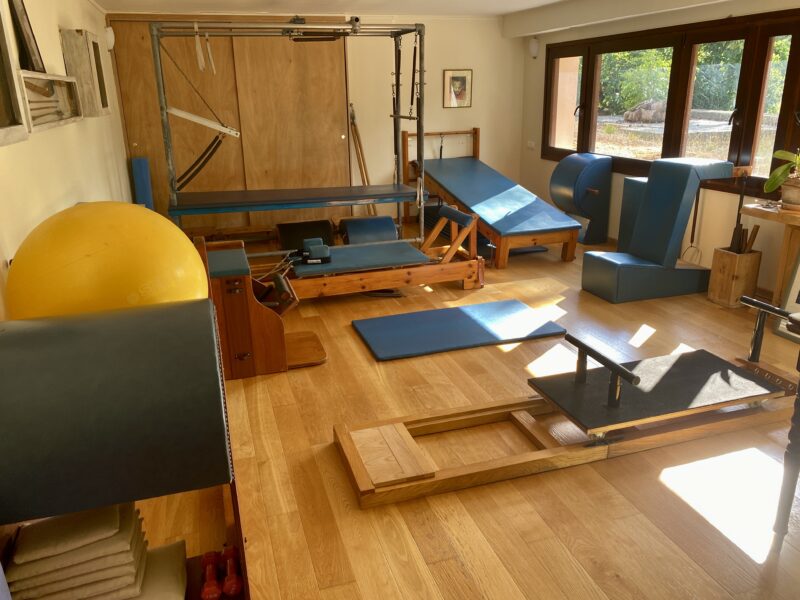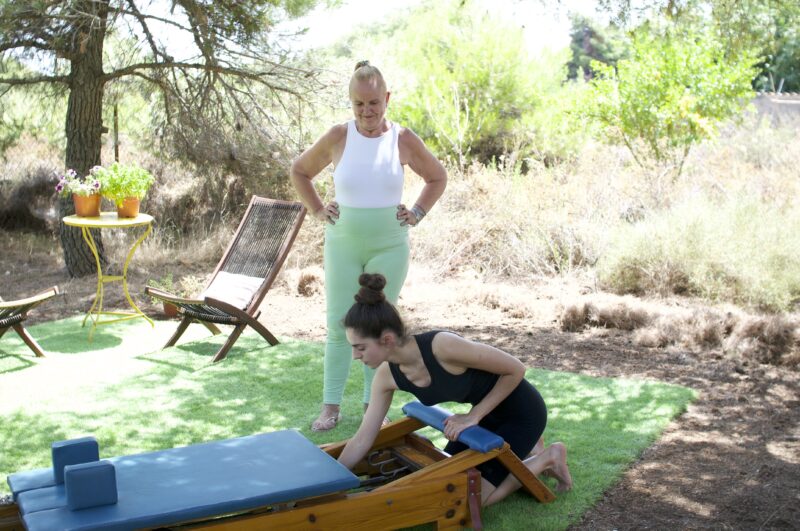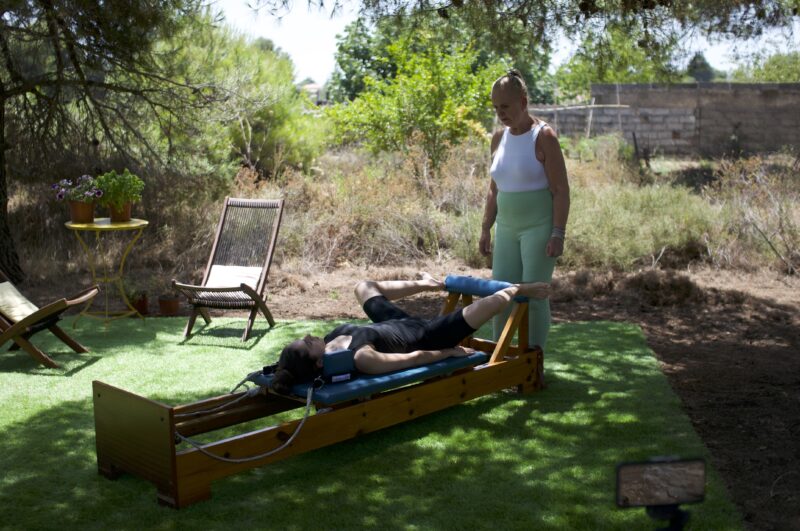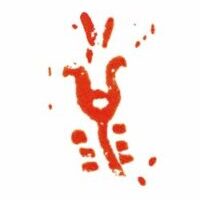PART 1
PILATES’ EQUIPMENT IS YOUR BEST FRIEND

I first saw Pilates equipment, when I was sent down to the Pilates studio at the London School of Contemporary Dance in 1974. I was sent down, by Jane Dudley, because I had hurt my back! The equipment looked like torture instruments.
I now know the history of these strange machines. After years of working with them, I know the secret! These machines are actually your best friends. All Pilates equipment can be, and should, be used in a healing way, to make us feel better, lighter and pain free.
I am going to talk about the the foot work on Reformer and how these exercises can ease back pain and improve posture in this blog.
THE RESISTANCE OF THE SPRINGS

It is natural to first think that the resistance of the springs is to principally to strengthen muscles.
The springs are actually used as a source of support rather than something to fight against.
Pilates used heavier springs for beginners. The more advanced the student, the lighter the springs, and the fewer.
My teacher Jerome Andrews was a professional dancer, went to Pilates, as many did, because he had an injury. Because he was strong and well trained, Pilates only used one light spring on the Reformer for Jerome. Why? The less support, the harder the exercise. For this reason the Mat Work is much harder than the exercises on the equipment.
I suggest when you do the Foot Work that you use a combination of springs that is just enough to give you support, so no not too light, and not too heavy. The springs are too heavy if you are having difficulty pushing out the machine. It should not be a struggle. If it is too heavy you will not be able to focus on the details of how you do the exercise.
SITES OF SUPPORT. THE SURFACE. THE BED.
Pilates was a genius. He designed his equipment responding to the needs of his clients. He initially attached springs to the hospital beds, to help soldiers recuperate from their war injuries. His designs became ever more sophisticated. He had a workshop next to his studio where he built equipment which would help with an issue that he was seeing in his classes.
SURRENDERING THE BACK OF THE BODY TO GRAVITY
The bed of the Reformer acts as a guide for the spine and the back body.
A lot of Pilates’ exercises are non weight baring, that is you are lying down. This is deliberate. The student is able to surrender the weight of his body to gravity. He or she is able to relax. As he or she relaxes the student lets go of familiar holding patterns that may in fact be unhelpful.
There is a sense of being supported, which is very important for people with tension in the shoulders, upper back and kyphosis. The instructor can see a literal transformation in the upper back when a student learns to surrender the natural weight of the upper body.
Be very careful to not confuse surrendering the back of the body to gravity and pushing the back down. This has a completely different energy and can lead to a lot of imbalances.
PILATES DID NOT USE A LOT OF PADDING OR UPHOLSTERING BECAUSE HE WANTED HIS STUDENTS TO BE ABLE TO FEEL THE SPINE.
According to Jerome, who worked with Pilates for 10 years, Pilates did not use a lot of padding or upholstering because he wanted his students to be able to feel the spine. Jerome’s folding Reformer, which I was lucky enough to make a direct copy of, had no padding at all. Dancers are used to working this way. They are used to lying on floors to exercise.
TRIANGLE OF THE PELVIS
Some people have more pronounced spinal curves. In order to be absolutely certain that we are not, in any way, forcing or pushing our back down we can check the boney parts of our pelvis. These bones act like a map, or a guide, for us when we are finding a new state of balance in the body. The 3 boney landmarks are, the pubic bone, and the 2 front boney parts of the illiac crests. These boney land marks form an upside down triangle. These 3 points, at all times, need to be parallel to the floor, on a level with each other. The minute you feel, for example, the pubic bone move more forward of the other two bones, you are “tucking”. In other words you are causing the natural curve of your lower back to be falsely straight. This over time will cause injury without a shadow of a doubt especially if you are exercising with the resistance of the springs. STOP. START AGAIN, AFRESH. DO NOT REPEAT OLD BAD HABITS. The same goes with having the pubic bone more back. We are very conscious, very aware, every second in time, when we exercise.
THE BAR ON THE REFORMER

The bar on the Reformer is deliberately set higher than the bed making it easier for us access the power of the pelvic floor and internal abdominal muscles which are our essential support or power house as Pilates called it.
Having the feet higher is more restful, for the back and the heart. It is better for our circulation.
It easier to “rest” the feet on the bar and as a result it is easier to be sure the hip joints are relaxed. This in turn helps the back to be relaxed. The knees and ankles can be soft. Joints are designed for movement not support.
THE BAR ON JEROME’S REFORMER IS ROUNDED
I learnt a lot about the details about how you very meticulously use the feet during the footwork with Jerome. I saw clearly with my own eyes, (because he made us work with bare legs), how, with each nuance, the leg muscles worked differently.
The wrapping of the feet and toes in “Bird Feet” was even more supported with the round bar.
Whichever type of bar you may have it is important to use it well. The bar is another site of support. Spread the toes, especially between the big toe and second toe when working with positions on the toes, so that you have as large a surface area as possible for support. The toes are long, absolutely not tense, and meld into the bar.
SCOLIOSIS
The Reformer is great for people with scoliosis. Apart from everything I have said previously, the bed of the Reformer acts as a guide so you can be conscious, and adjust as you push out, that the back of the pelvis and the back of the ribs are evenly dropped to gravity. Once again, if you realise that the one side of the pelvis is “lighter”, not so surrendered to gravity, at some point in your movement STOP. START AGAIN, AFRESH. DO NOT REPEAT OLD BAD HABITS. Yes it does require patience and intense focus, but believe me, it is well worth it. The next time you come to do these exercises, I guarantee, it will be much improved. The body is very forgiving! It gravitates to what is good for it.
PRESS EVENLY WITH BOTH FEET
Pressing evenly with both feet is important for us all, however, it is something people with scoliosis need to be very vigilant about. Again, do not continue with a mistake. Stop immediately you realise, and start again. You will be surprised at how fast your body learns.
OPENING UP SPACE IN THE SPINE
We can use the support of the springs to open space in the spine. This is something positive for all of us but especially beneficial for those with scoliosis.
Press out and when you get to the top of the movement give yourself an extra breath.
Focus on the top of the head, the part that was soft when you were a baby. Imagine there is a string there extending out, along your axis, to the space above you. Imagine someone or something is pulling you back into that space. Literally, when you first bend the knees to start the downward movement ,the bed will not move, because you have lengthened so much. As you continue coming down keep that energy coming out through the crown of the head. The spine is light and long.
Oftentimes the way way we practice is like putting together pieces of a jigsaw. Yes, we focus on lengthening the spine, but we still surrender the back of the body to gravity, have our joints soft etc all at the same time.
LORDOSIS
Good practice is good practice and everything I have said previously applies to those humans who have lordosis. Very few people have actual lordosis, it is usually postural.
Check out the triangle of the pelvis and the surrendering of the back of the body to gravity. You may need to focus, more, on the lumbar spine, make sure you relax it and surrender it to gravity. You may have a habitual tension in the lower back which you will need to address with loving care and simply NOT anymore tense there to do something.
Please look at my previous blog about leg alignment. Good leg alignment is essential to easing back pain. https://jennycolebourne.com/good-leg-alignment-is-essential-for-everyone/
My blog about openings is important for people with scoliosis. https://jennycolebourne.com/leg-openings-are-important-for-improving-scoliosis-kyphosis-back-ache-and-well-being/
I made three videos on You Tube about Footwork on the Reformer. One is about parallel position of the feet on the toes https://youtu.be/Vnfw4wkG35k , the other with the heels open or second position https://youtu.be/zvWamobo9FI and the tendon stretches https://youtu.be/7oYZGrLAOw8
Part 2 will be out at the end of August.
